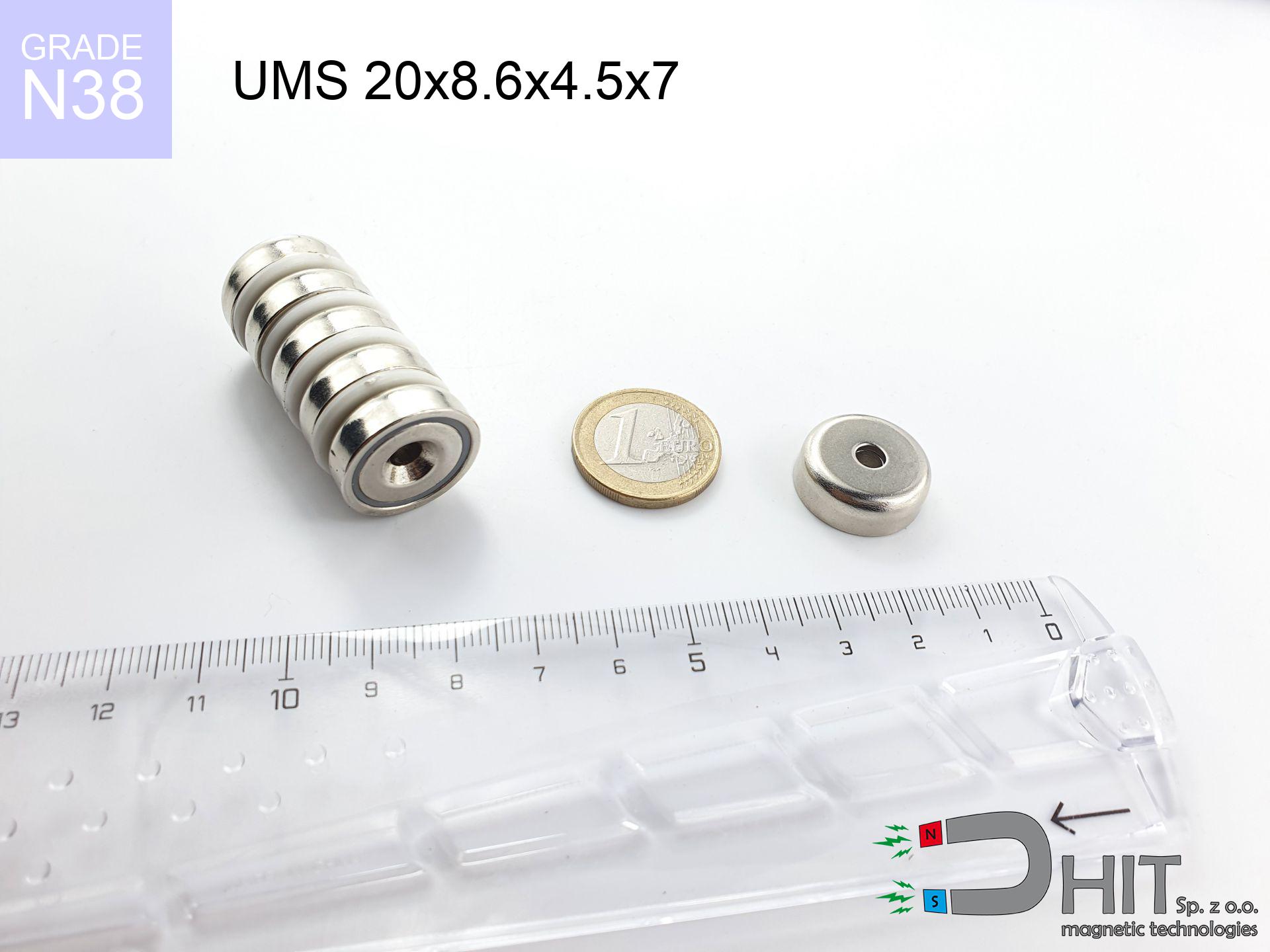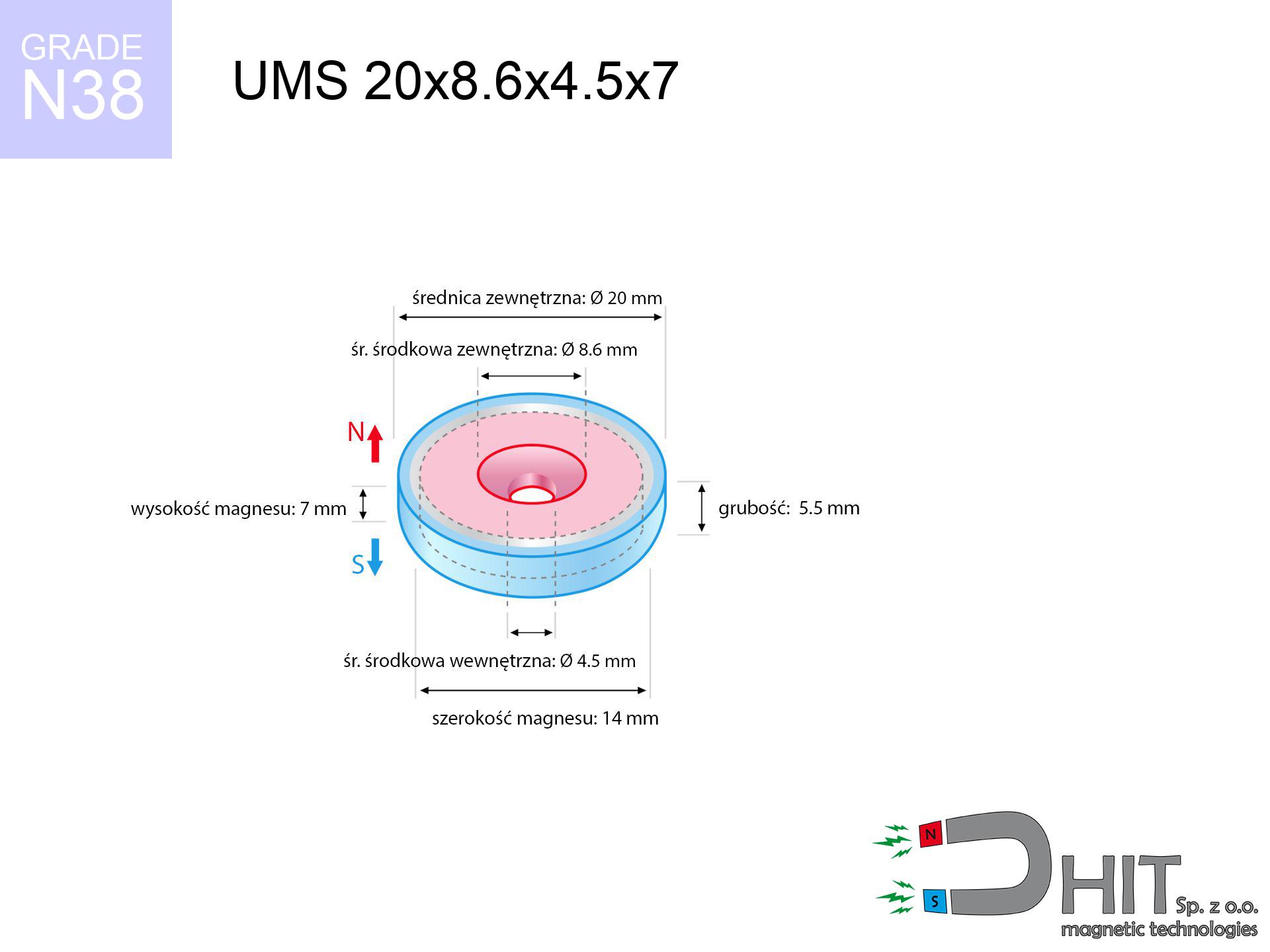UMS 20x8.6x4.5x7 / N38 - conical magnetic holder
conical magnetic holder
Catalog no 220327
GTIN/EAN: 5906301814177
Diameter Ø
20 mm [±1 mm]
cone dimension Ø
8.6x4.5 mm [±1 mm]
Height
7 mm [±1 mm]
Weight
12 g
Magnetization Direction
↑ axial
Load capacity
6.00 kg / 58.84 N
Coating
[NiCuNi] Nickel
6.46 ZŁ with VAT / pcs + price for transport
5.25 ZŁ net + 23% VAT / pcs
bulk discounts:
Need more?
Pick up the phone and ask
+48 22 499 98 98
otherwise get in touch through
inquiry form
the contact section.
Specifications along with form of neodymium magnets can be checked with our
force calculator.
Orders submitted before 14:00 will be dispatched today!
Technical details - UMS 20x8.6x4.5x7 / N38 - conical magnetic holder
Specification / characteristics - UMS 20x8.6x4.5x7 / N38 - conical magnetic holder
| properties | values |
|---|---|
| Cat. no. | 220327 |
| GTIN/EAN | 5906301814177 |
| Production/Distribution | Dhit sp. z o.o. |
| Country of origin | Poland / China / Germany |
| Customs code | 85059029 |
| Diameter Ø | 20 mm [±1 mm] |
| cone dimension Ø | 8.6x4.5 mm [±1 mm] |
| Height | 7 mm [±1 mm] |
| Weight | 12 g |
| Magnetization Direction | ↑ axial |
| Load capacity ~ ? | 6.00 kg / 58.84 N |
| Coating | [NiCuNi] Nickel |
| Manufacturing Tolerance | ±1 mm |
Magnetic properties of material N38
| properties | values | units |
|---|---|---|
| remenance Br [min. - max.] ? | 12.2-12.6 | kGs |
| remenance Br [min. - max.] ? | 1220-1260 | mT |
| coercivity bHc ? | 10.8-11.5 | kOe |
| coercivity bHc ? | 860-915 | kA/m |
| actual internal force iHc | ≥ 12 | kOe |
| actual internal force iHc | ≥ 955 | kA/m |
| energy density [min. - max.] ? | 36-38 | BH max MGOe |
| energy density [min. - max.] ? | 287-303 | BH max KJ/m |
| max. temperature ? | ≤ 80 | °C |
Physical properties of sintered neodymium magnets Nd2Fe14B at 20°C
| properties | values | units |
|---|---|---|
| Vickers hardness | ≥550 | Hv |
| Density | ≥7.4 | g/cm3 |
| Curie Temperature TC | 312 - 380 | °C |
| Curie Temperature TF | 593 - 716 | °F |
| Specific resistance | 150 | μΩ⋅cm |
| Bending strength | 250 | MPa |
| Compressive strength | 1000~1100 | MPa |
| Thermal expansion parallel (∥) to orientation (M) | (3-4) x 10-6 | °C-1 |
| Thermal expansion perpendicular (⊥) to orientation (M) | -(1-3) x 10-6 | °C-1 |
| Young's modulus | 1.7 x 104 | kg/mm² |
Elemental analysis
| iron (Fe) | 64% – 68% |
| neodymium (Nd) | 29% – 32% |
| boron (B) | 1.1% – 1.2% |
| dysprosium (Dy) | 0.5% – 2.0% |
| coating (Ni-Cu-Ni) | < 0.05% |
Ecology and recycling (GPSR)
| recyclability (EoL) | 100% |
| recycled raw materials | ~10% (pre-cons) |
| carbon footprint | low / zredukowany |
| waste code (EWC) | 16 02 16 |
View more products
Strengths and weaknesses of neodymium magnets.
Pros
- They have unchanged lifting capacity, and over more than ten years their attraction force decreases symbolically – ~1% (according to theory),
- They have excellent resistance to magnetic field loss when exposed to external fields,
- By using a lustrous layer of gold, the element presents an nice look,
- They feature high magnetic induction at the operating surface, which affects their effectiveness,
- Due to their durability and thermal resistance, neodymium magnets can operate (depending on the shape) even at high temperatures reaching 230°C or more...
- Possibility of precise modeling and optimizing to precise applications,
- Versatile presence in modern technologies – they find application in mass storage devices, electromotive mechanisms, medical equipment, as well as technologically advanced constructions.
- Thanks to efficiency per cm³, small magnets offer high operating force, in miniature format,
Cons
- At very strong impacts they can crack, therefore we advise placing them in strong housings. A metal housing provides additional protection against damage, as well as increases the magnet's durability.
- We warn that neodymium magnets can reduce their strength at high temperatures. To prevent this, we advise our specialized [AH] magnets, which work effectively even at 230°C.
- Magnets exposed to a humid environment can rust. Therefore during using outdoors, we recommend using water-impermeable magnets made of rubber, plastic or other material resistant to moisture
- We suggest casing - magnetic mount, due to difficulties in producing nuts inside the magnet and complex shapes.
- Possible danger related to microscopic parts of magnets can be dangerous, if swallowed, which gains importance in the context of child safety. Additionally, small components of these magnets can disrupt the diagnostic process medical when they are in the body.
- High unit price – neodymium magnets are more expensive than other types of magnets (e.g. ferrite), which can limit application in large quantities
Pull force analysis
Best holding force of the magnet in ideal parameters – what it depends on?
- on a plate made of mild steel, effectively closing the magnetic field
- possessing a massiveness of at least 10 mm to ensure full flux closure
- characterized by smoothness
- with direct contact (without coatings)
- during detachment in a direction vertical to the plane
- at ambient temperature approx. 20 degrees Celsius
Key elements affecting lifting force
- Space between surfaces – even a fraction of a millimeter of distance (caused e.g. by veneer or dirt) significantly weakens the pulling force, often by half at just 0.5 mm.
- Pull-off angle – note that the magnet holds strongest perpendicularly. Under sliding down, the holding force drops drastically, often to levels of 20-30% of the maximum value.
- Plate thickness – insufficiently thick steel does not accept the full field, causing part of the flux to be escaped to the other side.
- Material type – ideal substrate is high-permeability steel. Stainless steels may have worse magnetic properties.
- Surface finish – full contact is obtained only on smooth steel. Any scratches and bumps create air cushions, weakening the magnet.
- Thermal conditions – NdFeB sinters have a negative temperature coefficient. At higher temperatures they lose power, and in frost gain strength (up to a certain limit).
Lifting capacity testing was performed on plates with a smooth surface of optimal thickness, under a perpendicular pulling force, whereas under shearing force the load capacity is reduced by as much as fivefold. Moreover, even a slight gap between the magnet’s surface and the plate decreases the load capacity.
Warnings
Allergy Warning
Studies show that nickel (the usual finish) is a common allergen. If your skin reacts to metals, avoid touching magnets with bare hands or choose versions in plastic housing.
Immense force
Handle with care. Rare earth magnets attract from a long distance and connect with huge force, often quicker than you can move away.
Phone sensors
Note: neodymium magnets produce a field that interferes with precision electronics. Maintain a safe distance from your mobile, device, and GPS.
Dust explosion hazard
Powder produced during grinding of magnets is flammable. Avoid drilling into magnets without proper cooling and knowledge.
Heat sensitivity
Standard neodymium magnets (N-type) lose magnetization when the temperature goes above 80°C. Damage is permanent.
Threat to electronics
Data protection: Strong magnets can damage data carriers and sensitive devices (pacemakers, medical aids, mechanical watches).
Magnet fragility
Despite the nickel coating, the material is delicate and not impact-resistant. Do not hit, as the magnet may shatter into hazardous fragments.
Medical implants
Warning for patients: Powerful magnets affect electronics. Maintain at least 30 cm distance or ask another person to handle the magnets.
Swallowing risk
NdFeB magnets are not toys. Swallowing several magnets can lead to them connecting inside the digestive tract, which constitutes a direct threat to life and necessitates urgent medical intervention.
Serious injuries
Risk of injury: The pulling power is so great that it can cause blood blisters, pinching, and even bone fractures. Use thick gloves.




![SM 19x225 [2xM6] / N50 - magnetic separator SM 19x225 [2xM6] / N50 - magnetic separator](https://cdn3.dhit.pl/graphics/products/sm-19x225-2xm6-jis.jpg)
![SM 32x250 [2xM8] / N42 - magnetic separator SM 32x250 [2xM8] / N42 - magnetic separator](https://cdn3.dhit.pl/graphics/products/sm-32x250-2xm8-kex.jpg)
![SM 25x400 [2xM8] / N52 - magnetic separator SM 25x400 [2xM8] / N52 - magnetic separator](https://cdn3.dhit.pl/graphics/products/sm-25x400-2xm8-hoj.jpg)
![UMGW 25x17x8 [M5] GW / N38 - magnetic holder internal thread UMGW 25x17x8 [M5] GW / N38 - magnetic holder internal thread](https://cdn3.dhit.pl/graphics/products/um-25x17x8-m5-gw-dob.jpg)

